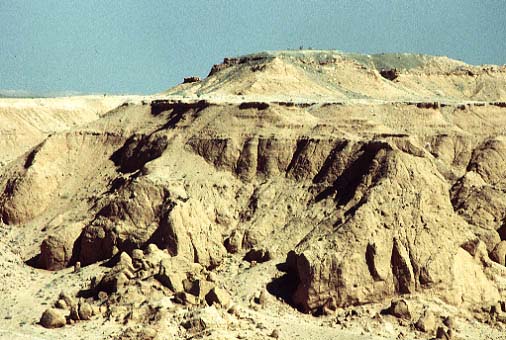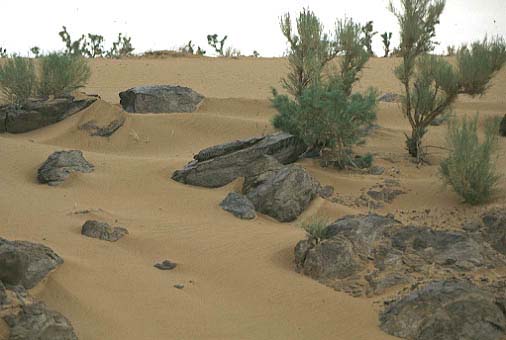 Since ancient times the word 'Gobi' meaning 'desert' in all Ural-Altaic languages was referred to in literature as shamo. It is on account of the fact that the word 'Gobi' is translated into many foreign languages as a desert. That foreigners often imagine the Gobi to a desert. However visitors to the Gobi are quickly persuaded that the word desert is a misnomer.
The Mongolian Gobi, a vast zone of desert and semi-desert occupying almost 30% of our country's vast territory, is a well-renowned place. The Gobi is often imagined to be place of unbearable heat and lifeless sand dunes, similar to the inhospitable and uninhabitable Sahara desert. Whereas the reality is quite the reverse. The Great Mongolian Gobi (the western part is located inside China, now) has high mountains, springs, forests, sands, steppe lands and rich animal kingdom, and has been inhabited since ancient times. To put it another way, the Mongolian Gobi has the vast plains of Europe, the majestic peaks and mountain ranges of Asia, the sand dunes and sandy valleys of Africa, and thus could be called the land of the three continents. You will see there an eternally clear sky, blue mirages, golden sands and boundlessly expansive steppe lands.
Furthermore, the Mongolian Gobi is not a single notion. There are no less than 33 different types of Gobi in Mongolia, of which sandy desert occupies only three percent of the total area. The Gobi is situated in the southern part of the country and it covers the provinces of East Gobi, Middle Gobi, South Gobi, and Gobi Altai, all sharing the name of Gobi. One of these four Gobi, the South Gobi occupies the biggest and southern most area, belong to the territory of the South Gobi aimak.
The Gobi houses enormous wealth including numerous rare animal species as for example the mountain sheep (argali), ibex, snow leopard, lynx, wild ass (khulan), gazelles, saiga, khavtgai (wild camel, ancestor of the bactrian camel), mazaalai (gobi bear), fox, wolf, steppe fox, as well as different trees and plants: khargana, tamarisk, red trees, and wild thyme to name but few. Equally there are a wealth of precious and semi-precious stones including turquoise, jasper, agate and crystal.
Once upon time, the Mongolian wild horse (takni) lived in Gobi desert. It is a best known animal as "Przewalski's horse" in the western zoo. Russian explorer, Przewalskii, introduced the Mongolian takhi to western Europe in XIX century. Many westerners and Russians came to capture the baby takhi, then packs of takhi rapidly reduced. The new born takhi can stand on the legs immediatelly. When hairs of the baby takhi became dry, nobody can capture it. In my childhood, my grandfather told me that "In the last time, I counted 14 takhi in my binocular, where they crossed the border from the southwest side of Aj Bogd mountain. They would not survive from the machine gun's fire of Chinese soldiers."
 |  |
 |
 |  History
In Neolithic times Mongolia was the home of small groups of hunters, reindeer breeders, and nomads. During the 3rd century BC it became the centre of the Hsiung-nu empire. During the 4th-10th century AD, Orhon Turks were prominent in Mongolia, and the Uighur of eastern Turkistan formed an empire in the north during AD 745-840 that was ended by an invasion of the Kyrgyz peoples. In the 13th century Genghis Khan (Temuujin) united the Mongol tribes, defeated the Tatars, and successively conquered Central Asia, the Persian Gulf region, and the southern Caucasus, all of which became part of the Mongol empire. Genghis' successor, Ugoodei (reigned 1229-41), attacked and overcame the Chin (Juchen) dynasty of China in 1234. The establishment of the Yuan, or Mongol, dynasty in China (1279-1368) was accomplished by the great Kublai Khan (reigned 1259-94), a grandson of Genghis. For several centuries after 1368 the Mongols were confined to their original homeland in the steppes, their energies mostly absorbed by internal rivalries. The last great Mongol leader was Ligdan Khan (reigned 1604-34), who united many Mongol tribes to defend their homeland against the rising power of the Manchu. After Ligdan's death, the Mongols were subdued by the Manchu and became part of the Ch'ing (Manchu) dynasty of China. A Mongolian national consciousness emerged in the mid-19th century, and, after the fall of the Manchu dynasty in 1912, Mongol princes, supported by tsarist Russia, declared the in dependence of Mongolia from China. When the tsarist regime fell in 1917, Mongolia reverted to Chinese control, but in 1920, during the Russian Civil War, it was invaded by a White Russian force of 5,000 men. Damdiny Sukhbaatar, supported by the Bolshevik administration in Moscow, organized a force that, with the help of Red Army troops, defeated the White Russians and drove off the Chinese in 1921. The Mongolian People's Republic was officially proclaimed on Nov. 26, 1924. Close political, economic, cultural, and ideological ties with the Soviet Union continued thereafter. In the 1960s and '70s Mongolia's relations with China worsened as Sino-Soviet relations deteriorated; but tensions between the two countries eased in the 1980s, leading to the reestablishment of diplomatic relations between Mongolia and China in 1986. Mongolia joined in the democratic revolutions that swept eastern Europe and the Soviet Union in 1990-91. The country subsequently underwent major political and economic reforms.
|
 |  |
 | |
|



